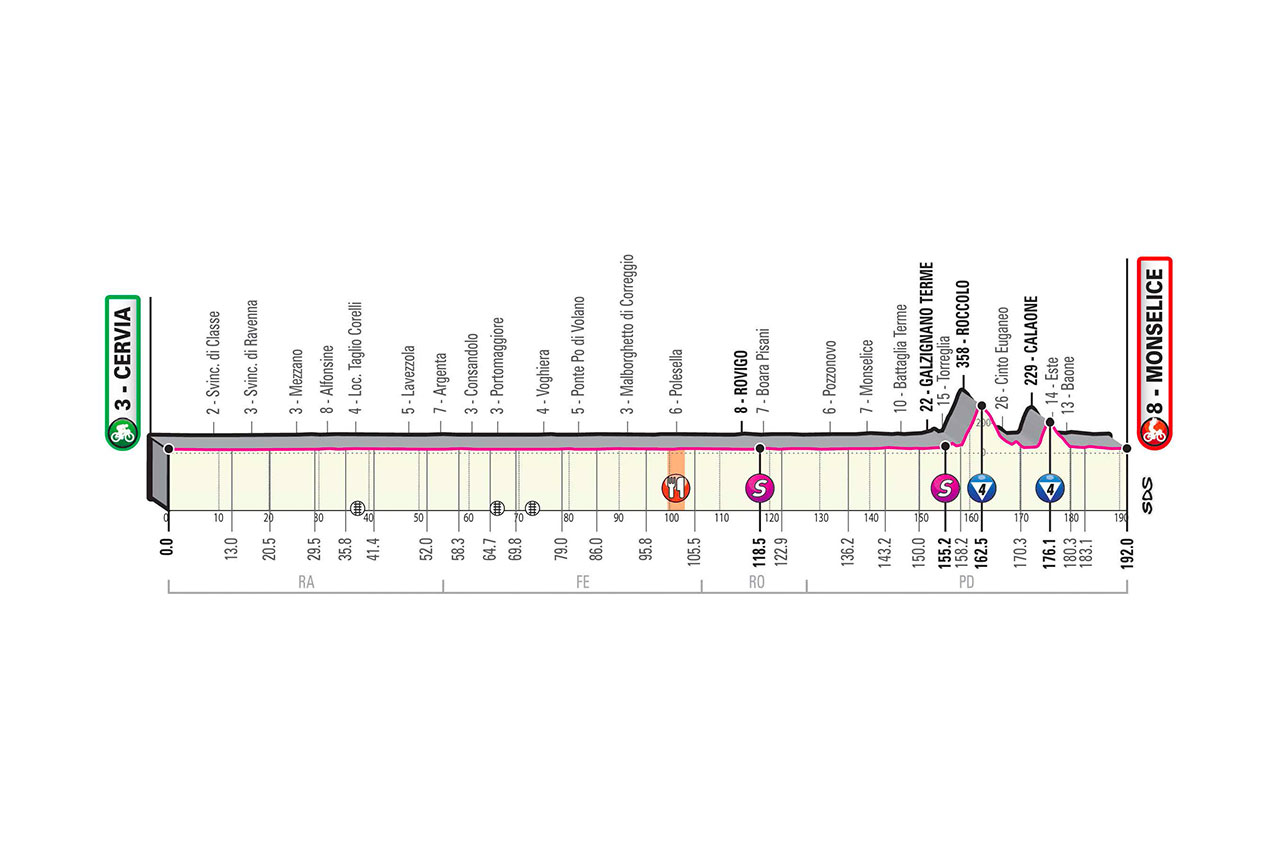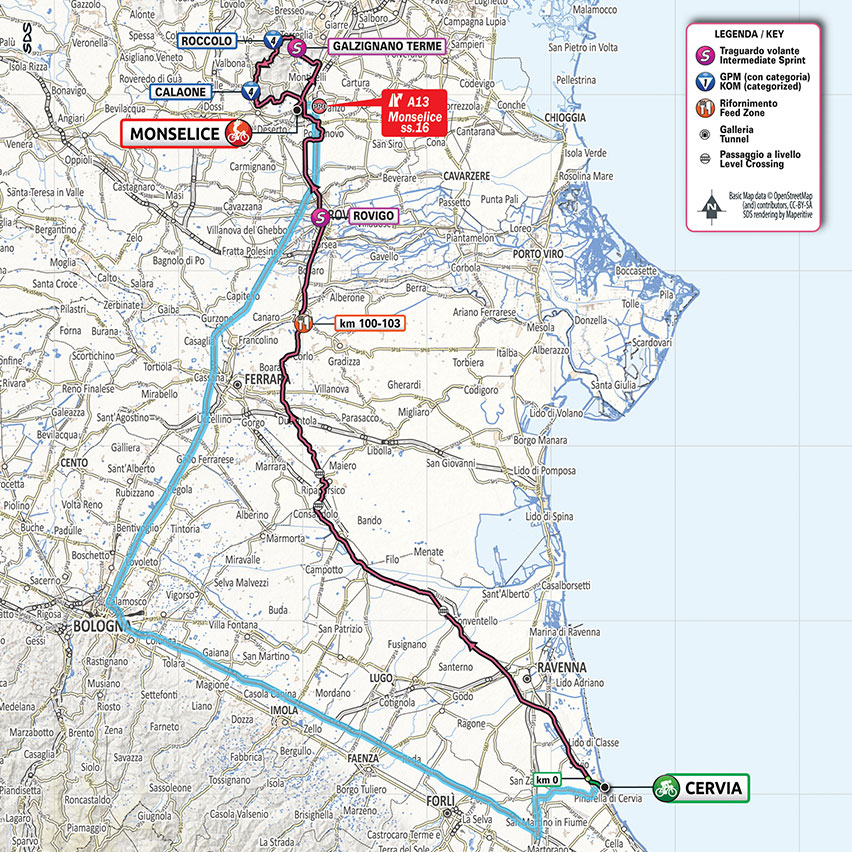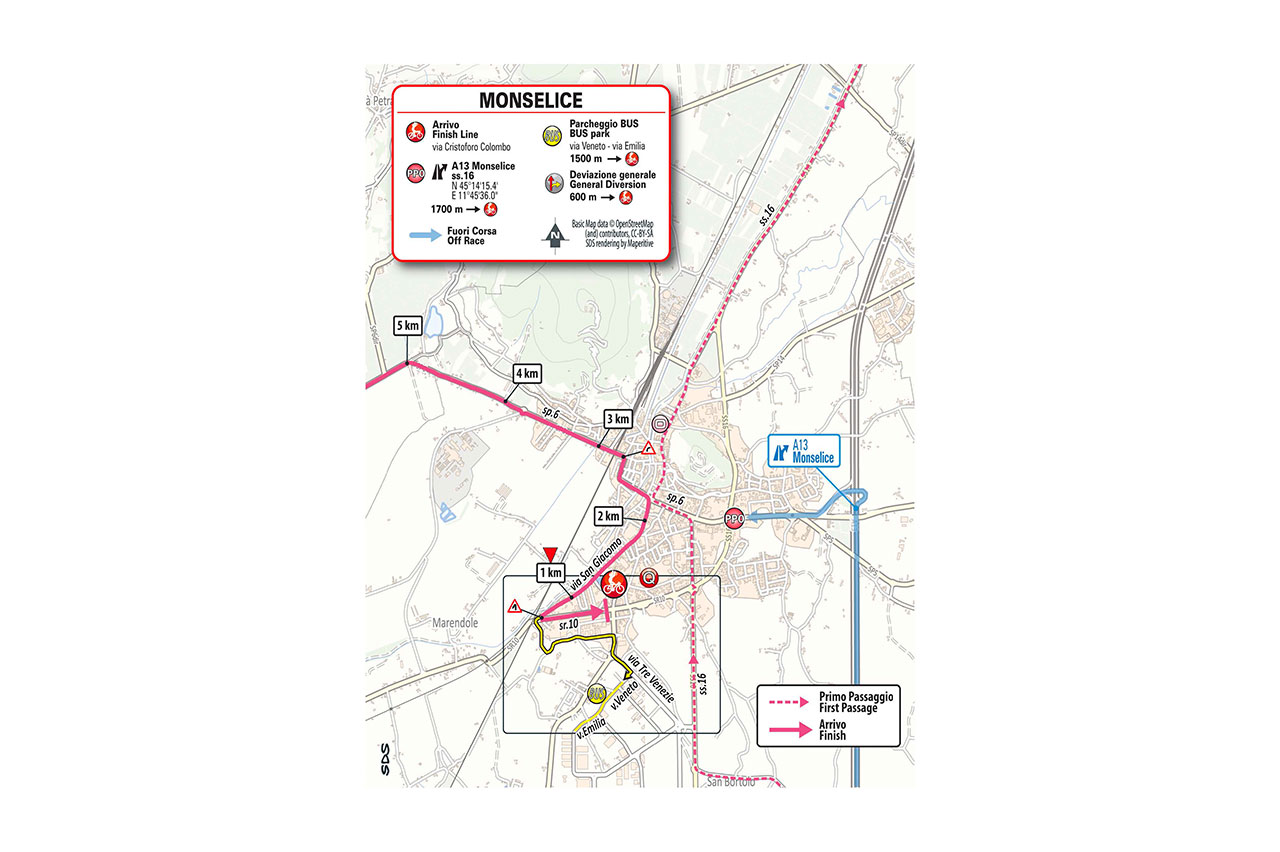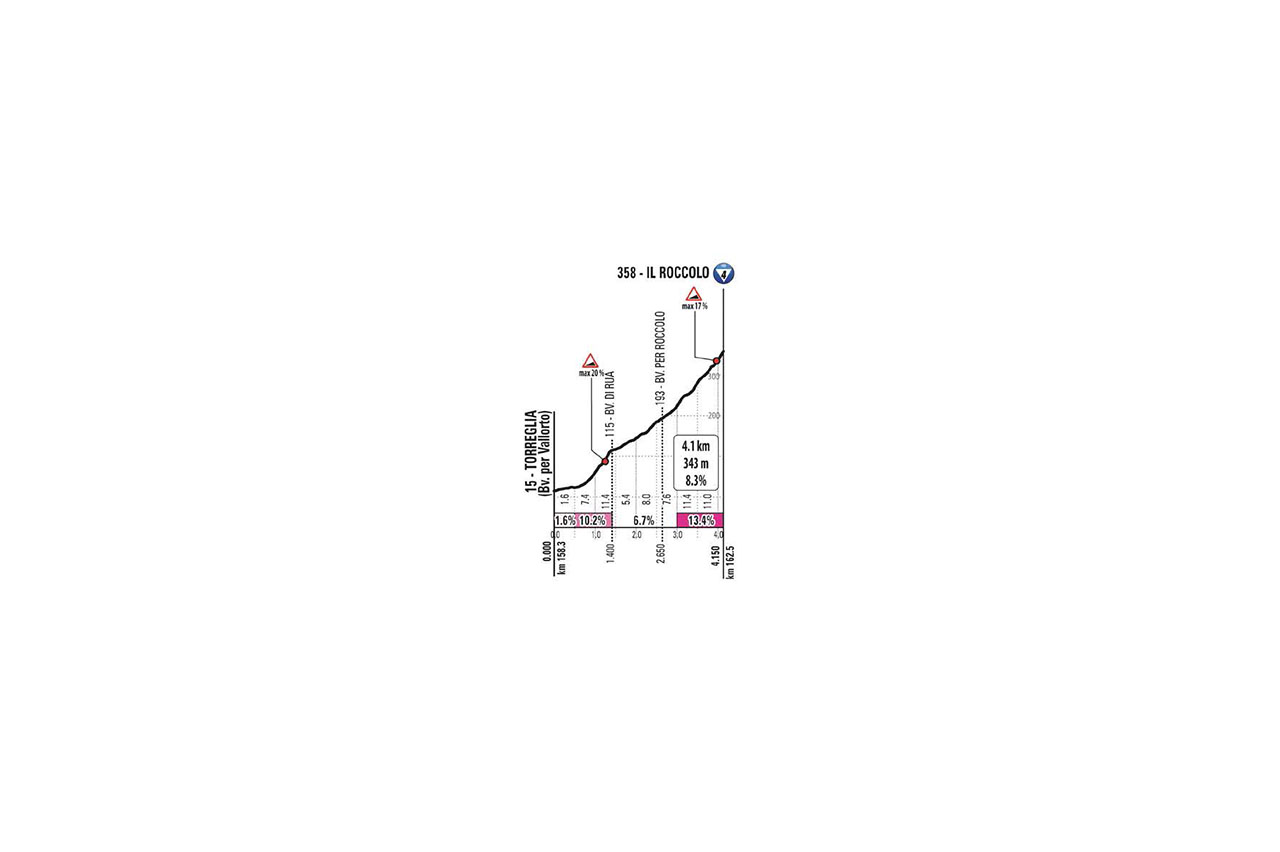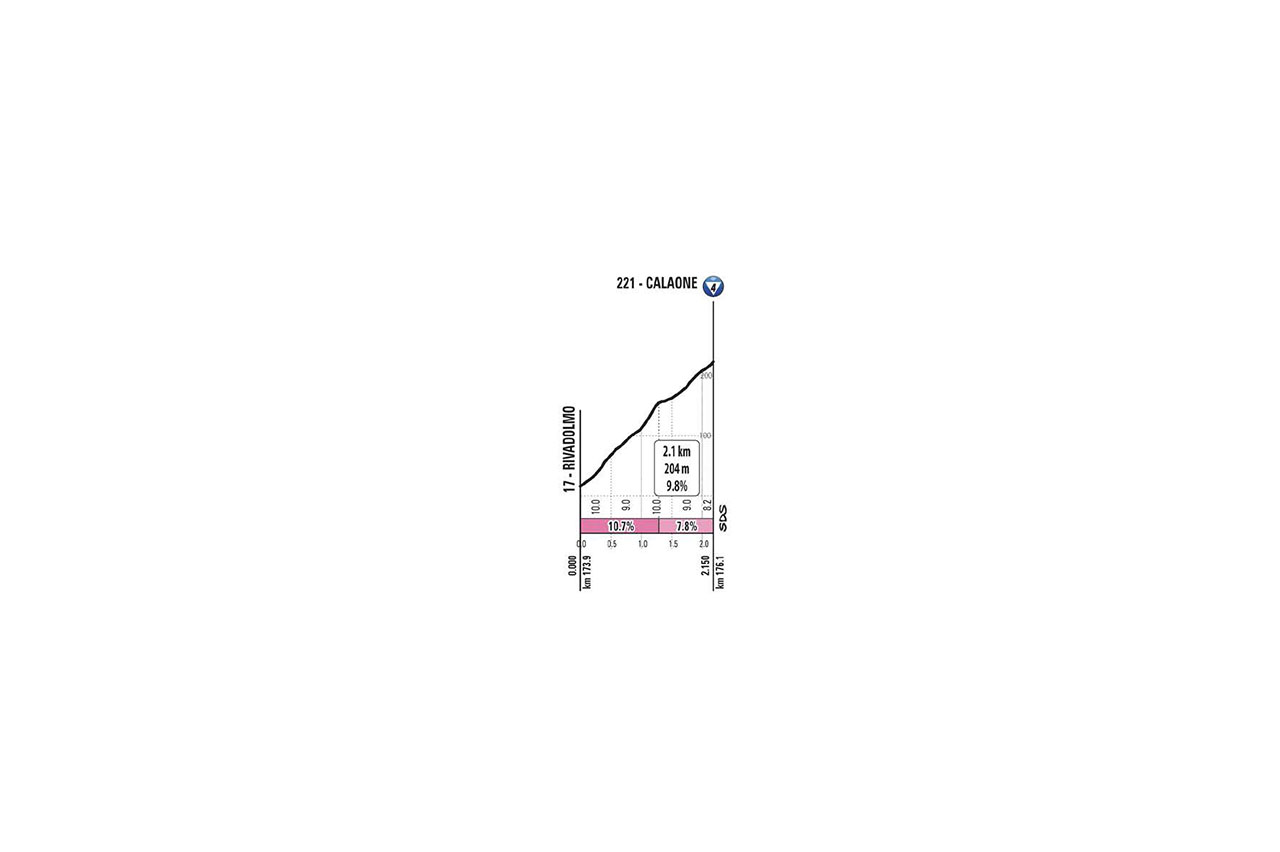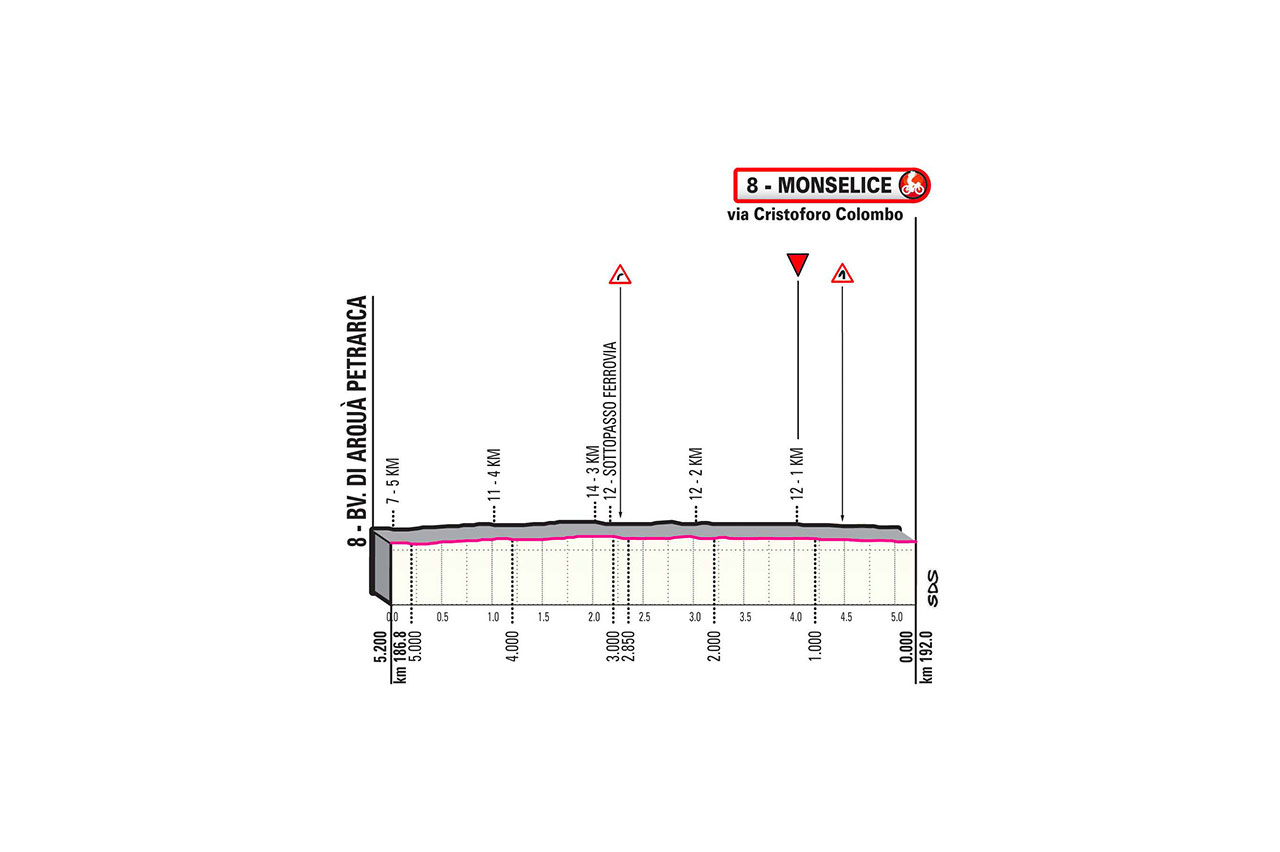profile
map
technical info
The Route
The stage runs perfectly flat across the Po Plain for 150 km, on straight roads (at times wide, at times narrower). As it takes its first pass through Monselice, the route draws a long, challenging “semi-circuit” of nearly 40 km, with two consecutive harsh climbs. Past Galzignano Terme, the route tackles the Roccolo, taking in 3 different climbs in a row (the Muro di Vallorto, max. 20%, the Castelnuovo climb and the “actual” Roccolo, max. 17%). The roads are relatively narrow, yet well-surfaced. The route drops into Cinto Euganeo and then tackles the Muro di Calaone (max. slope: 18%), coming from Rivadolmo, before heading for a fast stage finale.
Final kilometres
Over the last 15 km, the route descends rapidly along a large road with wide hairpins, from Calaone towards Este. Past Este, the route straightens and levels out, all the way to Monselice. With approx. 3 km to go, the stage enters the urban area coming from the railway underpass, with one last sharp left-hand corner 400 m before the finish, leading into the home straight, on 8 m wide tarmac.
start / finish
climb detail
final kilometres
itinerary timetable
tourist info
Host city:
Cervia
Overview
The Municipality of Cervia is situated in the region of Emilia-Romagna on a stupendous stretch of the Adriatic coast with 9 km of fine sandy beaches and shallow waters. The ancient “city of salt”, the old fishing village and the extensive pinewoods have been transformed by the development of tourism. This began in a pioneering way at the end of the eighteen hundreds and had a decisive impact in 1912 when the “garden town” of Milano Marittima was built at the edge of the centuries old pinewood. Cervia with its districts of Milano Marittima, Pinarella and Tagliata is now one of the most famous seaside resorts and a national and international reference model. A land of natural beauty, tradition, culture and history awaits you here, where there are many attractions if you are looking for a holiday with a focus on health, fun and relaxation.
Food
An important aspect of the tourism offer of Cervia is the food and wine. The “sweet” salt of Cervia, since 2004 a Slow Food Association product, distinguishes local cuisine in a really unique way. The best dishes to try are the traditional recipes, in particular tagliatelle and cappelletti, various sand wines of the coastal area and the more robust wines of the hill region. The local piadina bread can be tasted at the distinctive piadina kiosks.
Points of interest
The quality of the water, the coast, tourism services and friendliness toward the environment enabled Cervia to win the Blue Flag for the twenty-first time consecutively in 2019.
The area has a wealth of natural beauty, culture, history where there are many attractions if you are looking for a holiday with a focus on health and relaxation.
It is fascinating to walk through the centre and explore a town that was transferred literally brick by brick from its original location inland to the new location by the sea at the end of the 17th century.
Things not to be missed are the Salt Warehouses, now the home of important exhibitions and the MUSA (the Salt Museum), Saint Michael’s Tower, the Cathedral, Town Hall and Piazza Garibaldi which is the heart of the old centre.
Particularly interesting are the Civic Theatre, Church of Suffrage with its Callido organ, Saint Anthony’s Church, Piazzetta Pisacane, where the former historic building of the former fish market is located, and the port canal with the old lighthouse and distinctive fish market.
Every day there are shows, exhibitions, concerts, street markets to give life to these traditional places.
Milano Marittima is the youngest resort district of Cervia and as such it is the most vivacious. It is a fashionable place with many shops selling articles with famous designer labels, exclusive beaches and intense nightlife.
What makes Pinarella and Tagliata distinctive are the long beaches and pinewood along the coast with areas equipped for picnics and amusements for children.
Cervia and its districts enjoy a privileged position which makes it possible to alternate days at the beach with pleasant excursions inland to places steeped in history, tradition and delicious local products, and also to Ravenna, an important city of art and famous for its stupendous Byzantine mosaics which are now Unesco World Heritage.
Something of particular beauty is the “Il tappeto sospeso” (hovering carpet) fountain, a highly coloured mosaic carpet conceived by Tonino Guerra on the occasion of the 300th anniversary of the Founding of New Cervia.
Nestled in a pinewood that has existed for more than a thousand years is the Spa of Cervia which offers a wide range of aesthetic and therapeutic treatments using the properties of the mud and mother liquors of the salt pans.
In fact the liman (lagoon mud), which is an extremely valuable aid to health, is extracted from the Saltpans of Cervia which are now a nature reserve covering 827 hectares.
On account of the rich variety of birdlife the saltpans are now part of the Southern district of the Po Delta Regional Park.
Monselice
Overview
Monselice is a fortified town of ancient origin, surrounded by the enchanting scenery of the Euganean Hills. Located amid the green of the Po Valley a few kilometers south of Padua, it is nestled between two hills, Monte Ricco and Colle della Rocca. In its historic center it still retains the typical atmosphere of the past. The fortress of Frederick II, a mighty thirteenth-century fortress that dominates the Rocca (keep) Hill, has always been the historical symbol of the city which is in fact also called ‘La Città della Rocca’ (The town of the keep).
One of the most suggestive places of the town is the Via del Santuario, along which stand beautiful monuments, such as the ancient medieval Castle and the Jubilee Sanctuary of the Seven Churches from where a panoramic path leads to the top of the hill.
Food
The typical cuisine of Monselice is based on the great variety of seasonal products that grow on the Euganean Hills and combines the high quality of the local ingredients with a traditional genuine and simple cuisine. Here nature offers a great variety of wild herbs with cheerful names: Carletti, Bruscandoli (wild hops), Pissacani (dandelions), Rampussoi (rampion bellflower). Typical products include peas, the basic ingredient of the famous “risi e bisi” (rice and peas), asparagus and radicchio, a symbol of the Veneto region.
Specialties include bigoli al torchio, gnocchi al ragù, omelettes with wild herbs, musso in tocio with polenta (stewed donkey with white polenta). Among the cold cuts stand out the sopressa euganea and the Prosciutto Veneto Berico Euganeo DOP Ham, a fine artisan specialty with fragrant notes. The Berico Euganeo DOP Olive Oil, a fine artisan specialty with fragrant fragrances, accompanies all specialties.
Drink
Another strong point of the area is the production of wines: there are great elegant and complex red wines such as Cabernet, Merlot, Colli Euganei Rosso and white wines, Chardonnay, Pinot Bianco, Serprino, Moscato and the Fior d’Arancio.
Points of interest
The visit of Monselice starts from Piazza Mazzini, in the heart of the town, which is surrounded by interesting monuments such as the San Paolo Museum complex, the Palazzo della Loggetta and the Civic Tower, also known as the Clock Tower.
From here starts the via del Santuario street, which winding along the slopes of the Rocca Hill, allows you to admire the main town monuments.
The magnificent Castle, an early medieval fortress, renovated and enlarged between the thirteenth and fifteenth centuries, is fully furnished and boasts one of the best-stocked armories in Italy. Villa Nani with the scenic staircase. The ancient Pieve di Santa Giustina, one of the oldest religious buildings in town. Beyond the Porta Romana or Porta Santa is the Sanctuary of the Seven Churches, composed of small chapels named after the seven major Roman basilicas. The arrival point of the Via Sacra is the oratory of Saint George, the seventh and last church. The climb ends in the elegant Villa Duodo completed by the scenic exedra of San Francesco. Do not miss a visit to Villa Pisani, Villa Emo and Lispida Castle.
Top video

Highlights
































